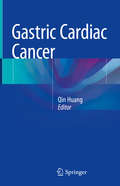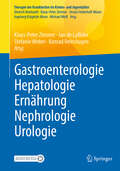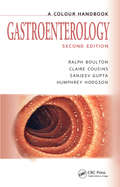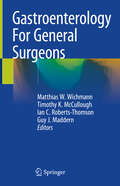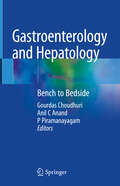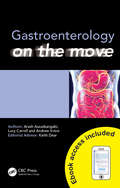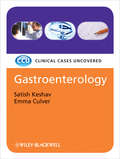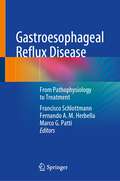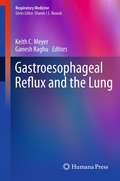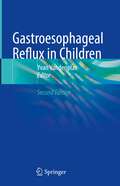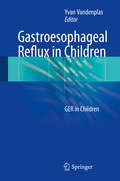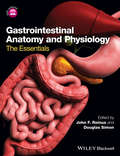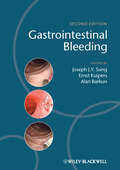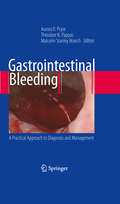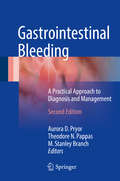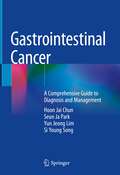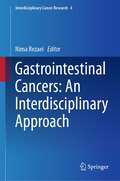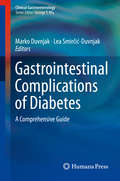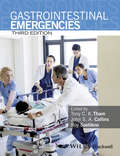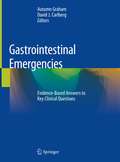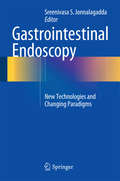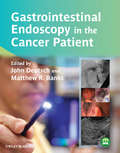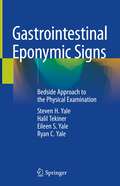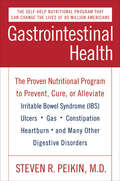- Table View
- List View
Gastric Cardiac Cancer
by Qin HuangThis book is designed to present readers with comprehensive, high-quality research results on almost all aspects of this carcinoma in clinical management, from correct determination of the esophagogastric junction, issues on cardiac mucosa, epidemiology, and natural history, to clinical, endoscopic, and histopathologic features and diagnostic pitfalls of this carcinoma at both early and advanced stages. Once diagnosed and correctly staged, clinical management of this carcinoma at the early stage is addressed primarily with endoscopic therapy employing the latest endoscopic technology such as endoscopic submucosal dissection, in which detailed technical topics of the endoscopic therapy are written by experts in the field with sections from pre-resection staging and patient preparation to post-resection complications and management. Subsequently, clinical management of gastric cardiac carcinoma at advanced stages is discussed at length with a personalized, multidiscipline approach with strategies from surgical resections with various methods, to pre-, peri- and post-resection chemoradiation therapies as well as the most advanced immunotherapy. A state-of-art approach with the results of meta-analyses and large-scale randomized double-blinded clinical trials are employed throughout these chapters. For patients at the terminal ill stage, the appropriate palliative care plan is presented by experienced clinicians armed with the latest clinical practice guidelines to better manage and help those patients in the last period of their lives.
Gastroenterologie – Hepatologie – Ernährung – Nephrologie – Urologie (Therapie der Krankheiten im Kindes- und Jugendalter)
by Klaus-Peter Zimmer Jan De Laffolie Stefanie Weber Konrad ReinshagenDas Buch aus der Reihe Therapie der Krankheiten im Kindes- und Jugendalter bietet Kinder- und Jugendärzten schnelle Orientierung als verlässlicher Therapie-Begleiter bei der täglichen Arbeit auf Station oder in der Praxis. Renommierte Autoren aus der pädiatrischen Gastroenterologie, Hepatologie und Ernährung sowie aus der Kinder- und Jugend-Nephrologie und Kinderurologie fassen aktuelle evidenzbasierte Empfehlungen mit dem Fokus therapeutischer Behandlungsstandards praxisnah und konkret zusammen. Flussdiagramme für komplexe Entscheidungsprozesse werden dem Leser als Online-Zusatzmaterial zur Verfügung gestellt.
Gastroenterology
by Sanjeev Gupta Ralph Boulton Claire Cousins Humphrey HodgsonCombining the advantages of a color atlas with those of a short text, the authors provide systematic coverage of the diseases and disorders of the digestive tract. The book is filled with high quality color imaging and diagrams and includes the latest developments in investigation and management with special attention to refinements in endoscopy an
Gastroenterology For General Surgeons
by Matthias W. Wichmann Timothy K. McCullough Ian C. Roberts-Thomson Guy J. MaddernThis book fills a void in the market for specialists who are working in areas without the support of gastroenterologists. Due to a lack of local expertise, treatment decisions in the field of gastroenterology frequently have to be made by non-gastroenterologists. The book addresses this problem by providing clear instructions on the diagnosis, medical management and on-going treatment of the most common disease patterns encountered in gastroenterology. Written by leading experts in their respective fields, it offers up-to-date evidence and insights into these conditions to enable adequate decision-making and safe management of these conditions.
Gastroenterology and Hepatology: Bench to Bedside
by Gourdas Choudhuri Anil C Anand P PiramanayagamThe book aims to be a handy compendium to the very voluminous texts of gastroenterology and hepatology existing in the knowledge market and provides the reader with an easy understanding of the bench knowledge (basic sciences) as they apply to bedside practice (clinical gastroenterology). With introduction and contributions from Prof Eamon Quigley, Former president of World Gastroenterology Organization and American College of Gastroenterology, the book covers the recent advances in the basic sciences that form an important pillar of the knowledge, thereby linking basic sciences such as anatomy, physiology, biochemistry, molecular medicine, etc. to clinical conditions, diseases and new therapeutic approaches in gastroenterology and hepatology. The book is written in a simple easy to read format, with a lot of diagrams and flowcharts, making it a handy guide. It also discusses in-depth about very common clinical conditions encountered in hospital settings such as ulcerative colitis, pseudomembranous colitis, colonic cancer, amebiasis, and various other syndromes and diseases. This book is a useful read for fellows and trainees in Gastroenterology and Hepatology, as well as gastroenterologists, hepatologists and physicians interested in digestive disorders.
Gastroenterology on the Move (Medicine On The Move Ser.)
by Andrew Irvine Arash Assadsangabi Lucy CarrollThe Medicine on the Move series provides fully-flexible access to subjects across the curriculum, in this case gastroenterology, in a unique combination of print and mobile formats. The books are ideal for the busy medical student and junior doctor, irrespective of individual learning style and whether they are studying a subject for the first time
Gastroenterology: Clinical Cases Uncovered
by Satish Keshav Emma CulverGastroenterology is a critically important specialty in medicine, encompassing the GI tract and two vital organs - the pancreas and the liver. Gastroenterology: Clinical Cases Uncovered includes reference to the new JCHMT curriculum for acute and internal medicine concerning gastroenterology and hepatology and presents real-life patient cases and outcomes as seen on the wards and in exams leading students through a practical approach to recognize, understand, investigate and manage gastroenterological and hepatological disorders and conditions. Following a question-answer approach, with self-assessment MCQs, EMQs and SAQs, and a 'refresher' section on basic science, Gastroenterology: Clinical Cases Uncovered features investigations and the treatment options available for patients with upper and lower GI disorders, liver disease, biliary and pancreatic disease, and problems of nutrition. Gastroenterology: Clinical Cases Uncovered is ideal for medical students, junior doctors on the Foundation Programme, GP trainees, specialist nurses and nurse practitioners and gastroenterology trainees on the specialty training programme.
Gastroenterology: Clinical Cases Uncovered (Clinical Cases #28)
by Satish Keshav Emma CulverGastroenterology is a critically important specialty in medicine, encompassing the GI tract and two vital organs - the pancreas and the liver. Gastroenterology: Clinical Cases Uncovered includes reference to the new JCHMT curriculum for acute and internal medicine concerning gastroenterology and hepatology and presents real-life patient cases and outcomes as seen on the wards and in exams leading students through a practical approach to recognize, understand, investigate and manage gastroenterological and hepatological disorders and conditions. Following a question-answer approach, with self-assessment MCQs, EMQs and SAQs, and a 'refresher' section on basic science, Gastroenterology: Clinical Cases Uncovered features investigations and the treatment options available for patients with upper and lower GI disorders, liver disease, biliary and pancreatic disease, and problems of nutrition. Gastroenterology: Clinical Cases Uncovered is ideal for medical students, junior doctors on the Foundation Programme, GP trainees, specialist nurses and nurse practitioners and gastroenterology trainees on the specialty training programme.
Gastroesophageal Reflux Disease: From Pathophysiology to Treatment
by Marco G. Patti Fernando A. M. Herbella Francisco SchlottmannThis textbook offers a state-of-the-art description of the pathophysiology, diagnosis and treatment of gastroesophageal reflux disease (GERD). Although GERD is one of the most common gastrointestinal disorders, its diagnosis and management are often challenging. Expert physicians provide an evidence- and experience-based analysis in each chapter.Aimed at primary care physicians, internal medicine doctors, gastroenterologists, pulmonologists, surgeons, and medical students, the goal is to have a comprehensive and detailed easy-to-read book.
Gastroesophageal Reflux and the Lung
by Ganesh Raghu Keith C. MeyerGastroesophageal Reflux and the Lung provides a comprehensive review of current knowledge concerning normal deglutition and foregut digestive processes and examines how abnormalities of swallowing or excessive/abnormal GER can lead to respiratory tract dysfunction and lung disease. In-depth Chapters deliver a concise review of the prevalence of GER in patients with lung disease and synthesize the current evidence regarding its diagnosis and management. Each chapter includes key points and a summary. In addition to outlining the current state of knowledge, each chapter provides a summary of ongoing research in the field and identifies the need for future research. Written by an international group of authors who are experts in their respective fields, Gastroesophageal Reflux and the Lung is a valuable resource for practicing clinicians, internists, pulmonologists and primary care personnel.
Gastroesophageal Reflux in Children
by Yvan VandenplasThis extensively revised second edition of this essential work provides a comprehensive overview of Gastroesophageal Reflux (GER) in children. It contains detailed insight into the epidemiology and pathophysiology of the condition. Relevant diagnostic methods and treatment techniques are also covered. Heavily revised chapters discuss issues associated with GER in special patient populations and current approaches to GER diagnosis and management. New chapters cover relevant aspects of the microbiome, how nutrition can be key to successful treatment and the adverse effects of the latest therapeutic drugs presently available. Colic in infants, and differential diagnoses in eosinophilic esophagitis are also described. The first part of the book is dedicated to introducing the condition, discussing epidemiology, symptoms and diagnosis. This is followed by addressing issues of the condition encountered in special patient populations such as in preterm infants, apnea, neulorogic patients and cystic fibrosis, among others. The final part of the book is dedicated to therapeutic approaches from medication to surgery and alternative approaches such as complementary medicine and hypnotherapy. The approaches and challenges in endoscopy are also detailed.Gastroesophageal Reflux in Children, Second Edition is edited by a leading world expert in the topic and written by a global team of authors from a range of associated disciplines, making the work a critical resource for pediatricians, gastroenterologists to pulmonologists, otolaryngologists and neurologists.
Gastroesophageal Reflux in Children: GER in Children
by Yvan VandenplasThis book provides a comprehensive overview of Gastroesophageal reflux (GER) in children, discussing its epidemiology, pathophysiology diagnosis and treatments. Readers will discover diverse perspectives of the contributing authors and extensive discussions of issues including GER in special patient populations and current approaches to GER diagnosis and management. The first part of the book is dedicated to introducing the condition, discussing epidemiology, symptoms and diagnosis. This is followed by addressing issues of the condition encountered in special patient populations such as in preterm infants, apnea, neulorogic patients and cystic fibrosis, among others. The final part of the book is dedicated to therapeutic approaches from meditation to surgery and alternative approaches such as complementary medicine and hypnotherapy. The approaches and challenges in endoscopy are discussed in a final chapter. Edited by a leading world expert i n the topic and written by a global team of authors, this book will appeal to a wide readership from pediatricians, gastroenterologists to pulmonologists, otolaryngologists and neurologists. For the first time, information on GER in patients 0--15 years is brought together in one volume, discussing all the key issues that for experts.
Gastrointestinal Anatomy and Physiology
by Douglas Simon John F. ReinusGastroenterologists require detailed knowledge regarding the anatomy of the GI system in order to understand the disturbances caused by diseases they diagnose and treat. Gastrointestinal Anatomy and Physiology will bring together the world's leading names to present a comprehensive overview of the anatomical and physiological features of the gastrointestinal tract. Full colour and with excellent anatomical and clinical figures throughout, it will provide succinct, authoritative and didactic anatomic and physiologic information on all the key areas, including GI motility, hepatic structure, GI hormones, gastric secretion and absorption of nutrients. GI trainees will enjoy the self-assessment MCQs, written to the level they will encounter during their Board exams, and the seasoned gastroenterologist will value it as a handy reference book and refresher for re-certification exams
Gastrointestinal Bleeding
by Joseph J.Y. Sung Ernst J. Kuipers Alan N. BarkunThere have been many advances in the management of this condition since the first edition of Gastrointestinal Bleeding. This new edition, thoroughly revised and restructured, includes the latest updates on all areas of the field of GI Bleeding, systematically covering all the areas of the GI tract, from upper GI to lower GI, through to small bowel bleeding. It fully covers the different types of bleeding that can occur, from peptic ulcer through to variceal bleeding and looks at new developments and pioneering techniques in the field, including endoscopy and balloon-enteroscopy. A methodology section describes the latest design of clinical trials in GI bleeding and this edition now highlights the new guidelines on UGIB (Upper gastrointestinal bleeding). This new edition of Gastrointestinal Bleeding is an invaluable purchase for all gastroenterologists, both in training and fully qualified.
Gastrointestinal Bleeding
by Aurora D. Pryor Malcolm Stanley Branch Theodore N. PappasThe diagnosis and management of gastrointestinal bleeding is multidisciplinary by nature involving surgeons, gastroenterologists and radiologists. Due to various pathologies, it involves upper gut, lower gut and occult bleeding. Gastrointestinal Bleeding: A Practical Approach to Diagnosis and Management covers all aspects of bleeding in a systemic approach organized by the site of bleeding. Elective and emergent bleeding is also covered. This volume provides a practical text for the practitioner in addressing patient issues in their practice, with a step-by-step approach through appropriate diagnosis and management strategies including surgical, endoscopic, medical and angiographic techniques, making this a truly multidisciplinary and disease based text. Specific sections in the book are crafted by experts in each topic. Gastrointestinal Bleeding: A Practical Approach to Diagnosis and Management provides a ready reference that will help physicians understand and work through diagnostic and therapeutic dilemmas and will be of great value to full range of practitioners that manage patients with bleeding including surgeons, gastroenterologists and radiologists as well as residents and fellows in these subspecialties.
Gastrointestinal Bleeding
by Aurora D. Pryor Theodore N. Pappas M. Stanley BranchThe latest edition of this text provides a practical reference for physicians and other health care providers caring for patients with gastrointestinal bleeding. Similar to the previous edition, this volume addresses common problems associated with gastrointestinal bleeding and discusses in a logical and step-wise fashion appropriate options for patient care. The text is structured based on the location of bleeding, with common, rare and unknown sources being addressed. It also includes updated and new chapters focusing on the newest advances in imaging and interventional modalities in the care of patients with GI bleeding, as well as highly practical presentations of typical patients seen in clinical practice. Written by world renowned experts in gastrointestinal diseases, Gastrointestinal Bleeding: A Practical Approach to Diagnosis and Management, Second Edition is a valuable resource in the management of gastrointestinal bleeding both for those currently in training and for those already in clinical practice.
Gastrointestinal Cancer: A Comprehensive Guide to Diagnosis and Management
by Hoon Jai Chun Seun Ja Park Yun Jeong Lim Si Young SongThere have been many advances in the diagnosis and treatment of cancer, but it is still a feared disease with a lot of work left to be done. The importance of gastrointestinal cancer as a frequently occurring disease goes without saying. It accounts for half of human cancer cases but differs from other forms of cancer. Complete prevention is possible through proper treatment of precancerous lesions. There is still no comprehensive book about prevention, early diagnosis, and proper treatment of precancerous lesions and new developed diagnostic modality, and treatment such as endoscopic treatment and minimal invasive surgery and chemotherapy and immunotherapy. Also, this book will contain conservative treatment methods for patients suffering from diverse complications. There will be plentiful clinical cases including endoscopic findings, radiologic images, pathology and treatment outcome in this book. For these reasons, this book will give very valuable information to many gastroenterologists, oncologists , surgeons and general physicians.
Gastrointestinal Cancers: An Interdisciplinary Approach (Interdisciplinary Cancer Research #4)
by Nima RezaeiGastrointestinal cancers are among the most prevalent malignancies worldwide, with high rate of global cancer incidence and cancer-related death. Gastrointestinal cancers include esophageal cancer, gastric cancer, colorectal cancer, pancreatic cancer, and liver cancer, which all, except the last one, are covered in this volume. The fourth volume of the “Interdisciplinary Cancer Research” series, entitled “Gastrointestinal Cancers: An Interdisciplinary Approach” publishes comprehensive volumes on mechanisms of gastrointestinal cancers and novel immunotherapy opportunities and presents the most updated and peer-reviewed chapters on gastrointestinal cancers therapy. This interdisciplinary series is of special value to researchers working on cell biology, immunology, biochemistry, genetics, and practitioners working on oncology and gastroenterology. This is the main concept of Cancer Immunology Project (CIP), which is a part of Universal Scientific Education and Research Network (USERN). This interdisciplinary book will be of special value for researchers, oncologists, and gastroenterologists who wish to extend their knowledge on gastrointestinal cancers.
Gastrointestinal Complications of Diabetes: A Comprehensive Guide (Clinical Gastroenterology)
by Marko Duvnjak Lea Smirčić-DuvnjakThis text provides a state-of-the art review of the gastrointestinal complications of diabetes, their pathophysiology, clinical manifestations, diagnostic evaluation and management. Divided into six sections, the volume shows how diabetes affects the entire GI tract, from the oral cavity and esophagus to the large bowel and anorectal region. By offering a detailed diagnostic approach and featuring therapeutic algorithms at the end of each chapter, the text is a useful guideline and reference point for every day practice, specifically in recognizing and diagnosing patients with gastrointestinal complications of diabetes in a timely fashion. Written by experts in the field, Gastrointestinal Complications of Diabetes: A Comprehensive Guide is a valuable resource for physicians dealing with diabetes mellitus or gastrointestinal disorders, and researchers interested in this multidisciplinary problem.
Gastrointestinal Emergencies
by Tony C. Tham Roy M. Soetikno John S. CollinsGastrointestinal Emergencies 3E provides practical, up-to-date guidance for gastroenterologists, endoscopists, surgeons, emergency and acute physicians, medical students and trainees managing patients presenting with GI complications and/or emergencies. Combining a symptom section, a specific conditions section and a section that examines complications (and solutions) of GI procedures, focus throughout is on clear, specific how-to guidance, for use before a procedure or immediately after emergency stabilization. An evidence-based approach to presentation, diagnosis and investigation is utilized throughout. New to this third edition are several brand new chapters covering various complications of procedures and specific conditions not previously featured, as well as a thorough look at the many diagnostic and therapeutic advances in recent years. In addition, every chapter from the current edition has undergone wholesale revision to ensure it is updated with the very latest in management guidelines and clinical practice. Once again, full range of emergencies encountered in daily clinical practice will be examined, such as acute pancreatitis, esophageal perforation, capsule endoscopy complications, acute appendicitis, and the difficulties after gastrointestinal procedures. International guidelines from the world's key gastroenterology societies will be included in relevant chapters. Gastrointestinal Emergencies 3E is the definitive reference guide for the management of gastrointestinal emergencies and endoscopic complications, and the perfect accompaniment for the modern-day gastroenterologist, surgeon, emergency and acute physicians. Every Emergency Department, GI/endoscopy unit, medical/surgical admission unit should keep a copy close at hand for quick reference.
Gastrointestinal Emergencies: Evidence-Based Answers to Key Clinical Questions (The\clinics: Internal Medicine Ser. #34-2)
by Autumn Graham David J. CarlbergThis book answers key questions asked by emergency clinicians faced with complex gastrointestinal and abdominal pain presentations. Instead of a traditional format that includes epidemiology, pathophysiology, diagnosis, and treatment options, this book takes an approach that mirrors the way clinicians interact with patients – by asking and answering specific clinical care questions. The book is organized into sections by presentation – gastrointestinal bleeding, for example – each of which contains chapters on specific questions, such as “What is the best clinical risk score for low risk GIB patients?” Each clinical question comes with a detailed, evidence-based response and a summary that gives best practices, recommendations, and references. Additionally, at the end of each section is a chapter titled “Expert Corner,” which asks the same clinical questions to a surgical or gastrointestinal specialist and includes key pearls these experts have for emergency medicine practitioners. Gastrointestinal Emergencies: Evidence-Based Answers to Key Clinical Questions is an essential guide for emergency medicine physicians, residents, and medical students who want to review and improve their care of acute gastrointestinal emergencies.
Gastrointestinal Endoscopy
by Sreenivasa S. JonnalagaddaThis comprehensive treatise on cutting edge tools and research provides a fascinating insight into the rapidly evolving field of diagnostic and therapeutic endoscopy. Accomplished international researchers and clinicians discuss the latest endoscopic advances in diverse areas including obesity and associated metabolic syndromes, management of peripancreatic fluid collections, endoluminal suturing techniques, fistula closure, management of Barrett's epithelium, cholangioscopy, chromoendoscopy, high resolution manometry and endoscopic ultrasonography. Gastrointestinal Endoscopy: New Technologies and Changing Paradigms is a valuable resource on the evolving role of endoscopic management of gastrointestinal diseases and is a tremendous resource for gastroenterologists, endoscopists, GI surgeons, and medical residents.
Gastrointestinal Endoscopy in the Cancer Patient
by Matthew R. Banks John C. DeutschThis book is a full colour, highly clinical multi-media atlas focusing on the role diagnostic and therapeutic endoscopy plays in the management of patients with cancer. Conveniently split into sections for each part of the GI tract, each section will follow a consistent structure. With 400 high-quality images and in addition, 21 high-definition videos showing endoscopy from the experts, this book is the perfect consultation and learning tool for all gastroenterologists, endoscopists, GI surgeons and oncologists.
Gastrointestinal Eponymic Signs: Bedside Approach to the Physical Examination
by Steven H. Yale Halil Tekiner Eileen S. Yale Ryan C. YaleThis book provides a novel method to teach eponymically named physical signs of the alimentary tract and intrabdominal organs. The focus is on the historical aspect of the named signs, how to perform the sign described by the author, and the pathophysiologic mechanisms involved in eliciting a positive test. The goal is to guide the reader to appreciate how these bedside signs provide a more profound understanding of the mechanism of disease. By doing so, they become more than simply rote memorization but an appreciation of how a direct hands-on assessment involving observing, engaging, listening, and touching the patient assists in diagnosis. Hence, these techniques provided the additional benefit of better connecting the practitioner to the patients and maintaining the art of medicine, which is rapidly losing its foothold within the medical community. This book will serve as a teaching tool for learners, teachers, and practicing physicians to preserve the art of the physical examination using a form of a case-based teaching and learning style approach. Illustrations throughout the text provide a visual representation of how to perform the sign. The authors believe this method of teaching and learning is more meaningful to the student in that they will be able to associate the name with the person's historical features, the sign, and its pathophysiologic mechanism(s). Gastrointestinal Eponymic Signs is a must-have resource for medical students, residents, fellows, teaching faculty, and any practicing physician seeking to understand how physical examination signs assist in diagnosis.
Gastrointestinal Health: The Self-Help Nutritional Program That Can Change the Lives of 80 Million Americans
by Steven R. PeikinDo you suffer from heartburn? Is an ulcer bothering you? Are the difficult symptoms of irritable bowel syndrome compromising your life? If so, you are not alone. You are that one out of every three Americans that suffers from chronic digestive problems.Whether it's constipation, diarrhea, gas, hemorrhoids, ulcers, heartburn, colitis, gallstones, or one of the many other digestive tract problems, Dr. Steven Peikin's self-help nutritional program will help keep you out of the doctor's office—and feeling great. Based on the latest research and his own clinical experience, Dr. Peikin prescribes a healthy diet high in fiber and low in fat, spices, lactose, and caffeine. He provides a detailed list of "flag foods" to avoid in the case of specific problems; shows you how to use exercise, over-the-counter drugs, prescription drugs, and stress management to complement the program; and offers advice for coordinating the program with weight loss (or weight gain), working with medical professionals, and measuring progress."Highly recommended for its thorough coverage, sound advice, and healthy suggestions,"* Gastrointestinal Health—now revised and updated with the latest information on new drugs and research—is everything you need to know to find fast relief from a wide range of gastrointestinal difficulties.Library Journal
